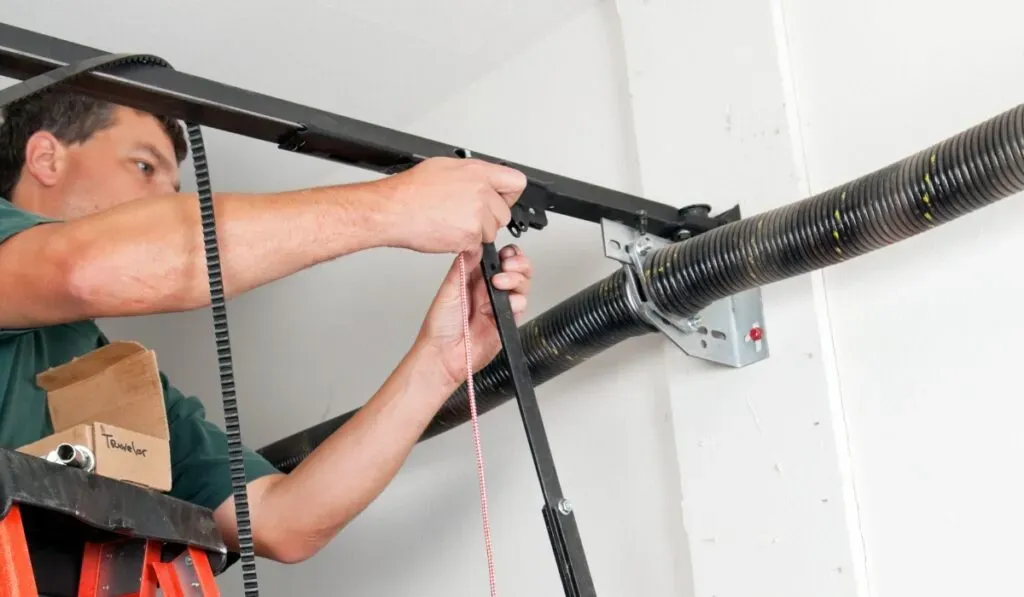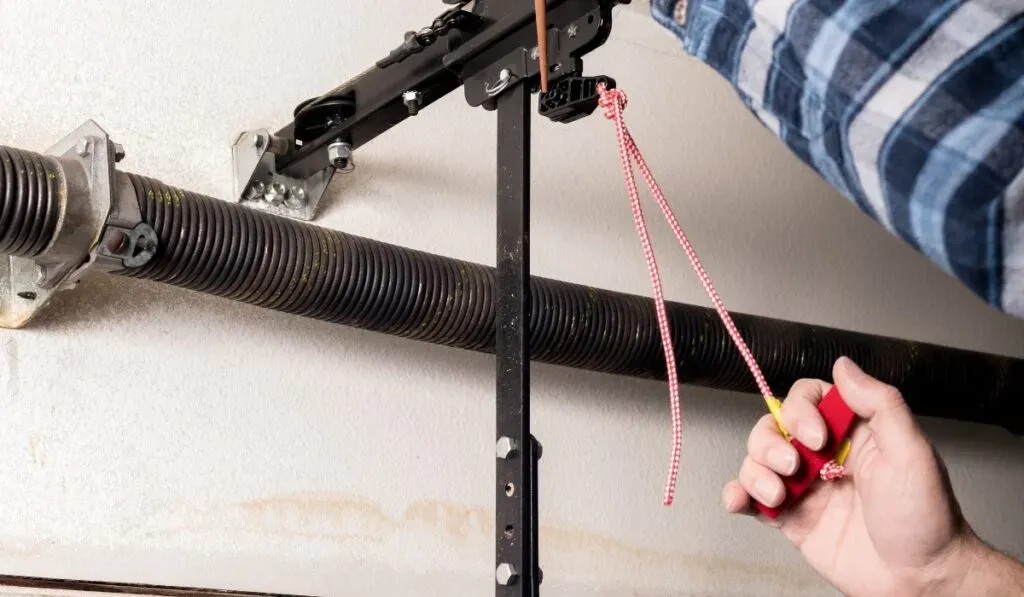
The garage door spring lifespan varies depending on usage and quality, but typically springs last between 7 to 12 years before showing signs of wear. Recognizing spring breakage and signs to replace springs early can prevent sudden failures and ensure timely garage door spring replacement.
Understanding Garage Door Spring Types and Lifespans
Garage door springs help lift and lower your garage door. They are a key part of your garage system. Knowing the types of springs and how long they last can save you money and trouble. There are two main kinds: torsion springs and extension springs.
- Garage door springs come in different styles.
- Each type has its own life expectancy.
- Using the right spring keeps your door working well.
Torsion Springs: Longer Lifespan and Balanced Door Support
Torsion springs sit above the garage door. They twist as the door moves up and down. These springs hold a lot of tension, which helps balance the door.
- Torsion springs last about 15,000 to 20,000 cycles.
- A cycle means one full open and close of the door.
- Proper balance stops extra wear on your garage door parts.
- It’s best to replace both torsion springs at once if one breaks.
- High carbon steel or oil-tempered springs resist rust better.
- These materials work well in salty or wet areas.
Extension Springs: Shorter Lifespan and Constant Tension
Extension springs stretch along the sides of your garage door tracks. They pull when the door opens and relax when it closes.
- Extension springs usually last between 5,000 and 10,000 cycles.
- These springs keep constant tension as they work.
- They don’t balance the door like torsion springs do.
- Constant tension can wear them out faster over time.
Extension springs don’t last as long but still do their job. Knowing these differences helps you decide when to fix or swap your garage door springs.
Remember, knowing your garage door spring types and their lifespan keeps things safe around your home. If you’re not sure about repairs, call a professional for help!
Factors Affecting Garage Door Spring Longevity
Knowing what affects your garage door spring lifespan can help you avoid surprise breaks. Several things decide how long springs last. These include how often you use the door, how heavy it is, the weather around your home, and the type of spring material used.
Usage Frequency and Cycle Counts
Garage door springs work by opening and closing many times. Each full open-and-close is one cycle. Most springs last about 10,000 cycles before they wear out. Some stronger springs go beyond 20,000 cycles.
- Cycle Rating: This shows how many times a spring should open and close before needing replacement.
- Usage Frequency: If your family uses the garage twice a day, that means about 10,000 cycles in 13 years (2 times × 365 days).
- Premature Wear: Using the door more than average speeds up spring wear and tear.
Keep track of how often you open the garage. Checking springs regularly helps spot problems early before a break happens.
Door Weight and Opener Performance
The weight of your garage door affects how fast the springs wear out. Heavier doors put more strain on springs.
- Heavy Garage Doors: Solid wood or insulated doors are usually heavier.
- Balanced Door Weight: When your door is balanced right, it puts less pressure on springs and opener parts.
- Opener Compatibility: The garage door opener must match your door’s weight to work well.
If your opener sounds like it’s struggling or working too hard, the springs might be under too much stress. This could lead to faster damage.
Environmental Conditions (Temperature, Moisture, Corrosion)
The weather around your home changes how fast garage door springs get old.
- Corrosion Impact: Springs get rusty if they sit in wet places.
- Coastal Environments: Salt air near oceans makes rust form quicker.
- Temperature Extremes: Cold makes steel brittle; heat causes metal to stretch over time.
Oiling the springs slows down rust but won’t stop it completely in bad conditions. If you live near the coast, check your springs more often for rust or damage.
Recognizing Signs of Garage Door Spring Failure
Garage door springs help your door move smoothly. But, over time, they wear out. Spotting garage door spring wear signs early can stop sudden failure. A broken garage door spring can snap without warning. That’s extremely dangerous for anyone nearby. Watch for warning signs to avoid safety concerns and costly damage. If you ignore them, you might face urgent repairs.
Look out for these signs:
- Loud or unusual noises from the springs
- Trouble opening or closing the door
- Uneven or unbalanced door movement
- Visible damage like cracks, rust, or gaps
- Sagging door or a door that slams shut
Unusual Noises (Popping, Scraping, Squeaking)
When your garage door makes odd sounds, it could mean spring problems.
- Loud popping often means a spring is about to break.
- Scraping noise may come from parts rubbing wrong due to damage.
- Loud squeaking points to worn springs that need help.
If you hear any of these noises, don’t wait. They show garage door spring noise signals that trouble is near.
Difficulty Opening or Closing the Door
Does your garage door feel heavy or slow? Maybe it sags when moving? These are bad signs.
- Sagging means the springs lost tension and struggle to hold weight.
- Uneven movement strains cables and tracks, causing more damage later.
If your door won’t open fully or closes with trouble, those springs probably need repair fast.
Uneven or Unbalanced Door Movement
A properly balanced garage door moves evenly on both sides. When one side lags or stops early, it means trouble.
- Weak springs cause uneven movement and poor balance.
- An unbalanced door puts extra stress on hardware parts.
- It also creates safety concerns because the door may fall suddenly.
Keep an eye on how smoothly your garage door moves each time.
Visible Damage (Cracks, Rust, Gaps, Discoloration)
Check your springs up close every now and then for clear signs of damage:
- Metal crack on springs shows they’re breaking down inside.
- Rusted garage springs appear reddish and flaky from moisture exposure.
- Spring corrosion weakens metal strength over time too.
- Noticeable spring gaps between coils mean serious fatigue.
If you spot any cracks, rust on springs, gaps, or strange discoloration—call a pro right away.
Sagging or Slamming Door
A sagging garage door looks like it’s drooping lower than usual when moving up or down.
Sometimes the door slams shut hard instead of closing gently. This happens because the springs fail to control its weight properly.
This problem can ruin your opener and is very dangerous if someone stands near when it falls fast.
The Importance of Professional Garage Door Spring Replacement

Garage door springs hold a lot of tension. Replacing them is not something you want to try without help. Without the right tools, the spring can snap suddenly. This snapping is extremely dangerous and can cause serious injury. Professional garage door maintenance uses special tools and safety steps to keep you safe. Trained professionals know how to avoid accidents and costly damage. If a spring fails immediately, you need urgent repairs. Only expert technicians should handle this kind of work. Getting professional spring replacement keeps your garage door working safely and smoothly.
Why You Should Choose Professionals:
- Garage door spring safety is tricky
- Specialized tools make the job safer
- Trained professionals avoid sudden failure
- Professional maintenance prevents unpredictable snapping
- Immediate failure needs urgent repairs
Risks of DIY Spring Replacement
Trying to fix your garage door spring yourself has risks. Most people don’t have the right tools or training. This lack can lead to incorrect installation or wrong garage door tension adjustment. These mistakes create big safety hazards that might hurt you or damage your door. Many DIY guides miss how powerful these springs really are. Even if you read garage door spring repair tips online, nothing beats real experience with high-tension parts.
Common DIY Risks:
- DIY garage door spring risks increase without tools
- Wrong tension adjustment causes accidents
- Incorrect installation can cause safety hazard
- Repairs done wrong may cost more later
Benefits of Professional Service
When you hire a trusted technician, you get expert service from people who know their stuff. Professionals use long-lasting springs made from durable materials. These parts often come with lifetime warranties for extra peace of mind. Besides installing springs, they do full safety inspections too. This helps catch problems before they turn into emergencies. Many services offer 24/7 emergency response so help is ready anytime you need it.
What Professionals Offer:
- Expert service with professional installation
- Long-lasting springs built from durable materials
- Lifetime warranty for extended durability
- Safety inspection catches hidden issues
- 24/7 emergency response for urgent needs
24/7 Emergency Response for Broken Springs
A broken garage door spring can fail right away. When this happens, you might need emergency garage door repair service fast. Skilled technicians respond quickly to fix broken garage door springs at any time. They stop more damage from happening and get your door working again safely through urgent repairs. If your spring breaks unexpectedly, calling for help right away keeps your home safe and cuts downtime.
Emergency Service Highlights:
- Emergency garage door service available 24/7
- Quick fix for broken garage door spring
- Urgent repairs prevent bigger problems
- Immediate failure requires fast attention
Garage Door Spring Replacement Costs and Warranties
When you need to replace a garage door spring, knowing the costs and warranties helps a lot. Prices change depending on what kind of springs you need and where you live. Labor charges also affect how much you’ll pay. The manufacturer cycle ratings tell you how long the springs last, which can change the price too.
Average Replacement Costs for Torsion and Extension Springs
Garage doors use two main spring types: torsion and extension springs. Torsion springs sit above the door and usually cost more to fix because they’re trickier to work with. Extension springs stretch along the sides of your door.
- Torsion Springs: They usually cost between $150 and $300 per spring.
- Extension Springs: These tend to cost $100 to $200 each.
- High Cycle Springs: These last longer (20,000+ cycles) but cost about 20–30% more. Still, they can save money over time by needing fewer repairs.
Labor rates differ by area, often adding $75 to $150 per hour. The total garage door repair costs depend on if you replace one or both springs. Experts suggest changing both so your door works smoothly.
Manufacturer Warranties and Guarantees on Spring Products
Most spring makers offer warranties that show how much they trust their products:
- Standard Warranty: Covers defects for 1 to 3 years.
- Lifetime Warranty: Some brands give this for their high-cycle or premium springs.
- Extended Durability Claims: They list cycle ratings (like 10,000 or 20,000 cycles). Usually, longer cycles mean longer warranty periods.
Check manufacturer specs before buying. Some warranties only apply if a pro installs the springs right.
Factors That Affect Replacement Pricing
Some things make replacement cost more:
- Door Size Considerations: Bigger doors need stronger or extra springs, which cost more.
- Garage Door Weight Impact: Heavy doors stress springs more. You’ll need higher-rated ones.
- Harsh Weather Conditions: Extreme heat or cold can wear parts faster. Coastal spots add salt air that causes rust.
These situations may mean you need special rust-resistant parts or more upkeep, which adds to the price.
